
Wine Culture and Information since 2002 - Volume 22
 Wine Culture and Information since 2002 - Volume 22 |
|
Contrasts of Nerello Mascalese and LagreinSicilia and Alto Adige are compared in our glasses, with two of the most significant red grapes of their respective territories, in a comparison rich of surprises |
|
Two distant territories, at the extreme borders of the same country - Italy - are being compared this month in our glasses by understanding the contrasts of two distant varieties. In our glasses we will in fact pour wines respectively produced with Nerello Mascalese - representing Sicily - and Lagrein, a typical red berried grape of Alto Adige (South Tyrol). Two grapes rich in personality and character which wines are capable of expressing elegance and class, although in different ways. Nerello Mascalese is particularly appreciated for its character of fine elegance making of crispness its most identifying element. Lagrein has an evidently more robust and full character, however capable of expressing organoleptic finesse and remarkable elegance. Distant grapes, on every regard, perfect to be used for a comparison by means of contrast technique which will let us understand their respective qualities and differences. The two varieties have a good wine making versatility. Nerello Mascalese is successfully used for the production of rose and red wines, including sparkling wines, also by using the classic method, that is refermented in bottle. On this regard, Lagrein shares the very same wine making fate with the Sicilian grape, widely used for the production of rose and red wines, including sparkling wines. However having distant characters, the grapes of our tasting by contrast seem to have their best expression in their respective lands of origin. Nerello Mascalese and Lagrein are in fact found, in a virtually exclusive way, in their respective regions of origin only, Sicily and Alto Adige. The productions made outside these two region are in fact pretty marginal when compared to the lands of origin, while making - in any case - interesting wines characterized by the typical personality of both grapes.
|
|
Nerello Mascalese is the queen grape of the territory around the majestic volcano Etna in Sicily. This variety has in fact established a strong bond with this territory, making wines capable of surprising the senses of wine lovers with their elegance, bringing Sicily to a new and surprising success. Frequently compared to Pinot Noir - Nerello Mascalese undoubtedly has its own personality - wines produced with the Sicilian variety can in fact recall those made with the famous Burgundian grape. Elegance, crispness, moderate astringency and sensorial complexity, as well as a good wine making versatility, are characteristics belonging to Nerello Mascalese and its wines. This is also thanks, undoubtedly, to the territory and soil of Etna - an area giving great character and expressive potential - Nerello Mascalese is capable of making rose, red and sparkling wines of remarkable elegance and finesse. The origins of Nerello Mascalese are uncertain despite it is present since some centuries in the territory around the volcano Etna. The name comes from Mascali - a municipality in province of Catania - area where it seems this variety is from, selected in the course of time from the vintners of this territory. The grape is mainly found in the north-eastern area of Sicily, however it is also present in the whole territory of the island and marginally in the southern area of Calabria. The cultivation of Nerello Mascalese is mainly done in the mountain territory of Etna and by using terraces made from lavic stones, at altitudes which can also be higher than 1000 meters. Queen grape of denominazione d'origine controllata Etna (denomination of controlled origin), Nerello Mascalese is also used for the production of wines in other Sicilian appellations. The territory of Etna certainly is the most significant and famous area, from which are produced the best Nerello Mascalese wines, mainly in the red, rose and sparkling styles, including classic method wines.
|
||||
|
Lagrein is the most famous and representative red berried grape of Alto Adige, having in the area of Bolzano the best territory. Grape capable of giving wines of structure and personality, Lagrein is successfully used for the production of rose wines that, in Alto Adige, are known as Kretzer. It is also interesting the use of this variety for the production of rose sparkling wines, in particular in Veneto. Moreover, Lagrein is successfully used with different wine making techniques, expressing a good personality both in the aging in inert container as well as in wood, such as cask and barrique. The origin of Lagrein are still today uncertain and also the place of origin is not clearly identifiable with Alto Adige, the land where Lagrein is considered to be autochthonous. There are however reliable information about the presence of Lagrein in Alto Adige since remote times, in particular in the area around Bolzano. The cultivation of Lagrein was regulated since 1097: edicts of those times in fact set the harvesting procedures for the monks of Gries. In 1370 emperor Charles IV forbade the supply of Lagrein wines to his armies, as this wine was believed to be too robust for the sustenance of the soldiers while preferring wines produced with Schiava grape. The robust structure of red wines produced with Lagrein - called in Alto Adige Dunkel (dark) - could be the reason which favored the production of the Kretzer style (rose), a more immediate and light wine. It should also be noted Dunkel was the preferred style for the tables of wealth and noble classes, whereas Kretzer was usually destined to the tables of the common people. Today Lagrein is still one of the most common red berried grapes of Alto Adige, protagonist of many of the great wines produced in this region.
|
|
For our tasting by contrast we will choose wines produced in the territory of Etna, as for Nerello Mascalese, and the area of Bolzano - as for Lagrein - possibly made in the area of Gries. In both cases, the general habit is to vinify Nerello Mascalese and Lagrein by using the cask or barrique. In choosing our wines, we will prefer those aged in cask in order to limit, as much as possible, the influence of wood in the organoleptic characteristics of wines. This is particularly true for Nerello Mascalese, because of its crisper and evidently less robust character than Lagrein. It must however be said, in general terms, producers of Nerello Mascalese rarely exceed in the use of wood, in order to keep and enhance the qualities of this grape. We will chose, in any case, wines having not more than two years, therefore pretty young. Nerello Mascalese and Lagrein will be poured in tasting glasses at the temperature of 18 °C (65 °F).
The evaluation of the wines' appearance is the phase starting our tasting by contrast. The first wine we will examine is Nerello Mascalese, of which we will observe both color and transparency. Let's tilt the glass on a white surface and observe the color at the base. The wine shows a beautiful brilliant ruby red color with a moderate transparency allowing us to clearly see the object put behind the glass. Let's now observe the wine at the opening of the glass - where the liquid mass is thinner - in order to appreciate nuances: the color is a pale ruby red. Let's now pass to the evaluation of Lagrein's appearance. The color of the wine from Alto Adige - observed at the base of the glass - reveals an intense ruby red and a pretty low transparency, completely different from Nerello Mascalese. Also nuances reveal an intense ruby red color, usually getting a purple hue, confirming the clear difference from the Sicilian variety. Nerello Mascalese and Lagrein express to the nose sensations directly recalling red and black fruits, as well as aromas belonging to the world of flowers. The aromas, in general terms, recall fruit and flower even though - in certain cases - are common to both varieties. Nerello Mascalese mainly expresses aromas of red fruits, such as cherry, raspberry and strawberry, to which are added blueberry, plum and the aromas of flowers, such as violet and cyclamen. Lagrein, like to say, expresses a more dense and compact nose, characterized by black fruits, such as black cherry, plum, blackberry and blueberry, as well as sensations recalling violet. Moreover, sometimes in Lagrein can be perceived aromas of raspberry and strawberry, including black currant. Both varieties, like we already said, are well suited for the vinification in wood, therefore in wines produced with these varieties can be perceived the aromas typical of this technique. It should be said, for the vinification of Nerello Mascalese, producers tend not to exceed with the use of wood in order to keep the characteristic crispness. The evaluation of the olfactory profile of the wines of our tasting by contrast starts from Nerello Mascalese produced in the territory of Etna. Let's hold the glass in vertical position and, without swirling, proceed with the first smell in order to evaluate the opening of wine. From the glass are perceived aromas of cherry, plum, blueberry and raspberry, confirming the typical expression of red fruits. After having swirled the glass, the olfactory profile of Nerello Mascalese is completed by violet, cyclamen and strawberry to which is not rare to also perceive rose and geranium. Let's now pass to the evaluation of Lagrein. The opening of the wine from Alto Adige gives the nose aromas of black cherry, plum, blackberry and blueberry, clearly expressing sensations recalling dark fruits. After having swirled the glass, the olfactory profile of Lagrein is completed by violet and, frequently, pomegranate and black currant. Let's now compare the two glass: differences of the wines are clearly evident. Differences between Nerello Mascalese and Lagrein continue to be clearly evident also in the phase of tasting. The first wine of which we will evaluate the gustatory profile is Nerello Mascalese. The attack of the Sicilian wine - that is the sensations perceived at the first sip - is characterized by a pleasing structure in which emerges the typical acidity of this variety. Moreover, it is also perceived a pleasing astringency opposed to the effect of alcohol, as well as a good correspondence to the nose expressed by cherry, blueberry and raspberry. Let's now pass to the evaluation of Lagrein's attack. In the mouth the wine from Alto Adige develops a fuller structure than Nerello Mascalese as well as a more intense sensation of astringency. Crispness is lower than the Sicilian wine, not the effect of alcohol, clearly in good evidence. Correspondence to the nose is very good: black cherry, plum and blackberry are the main flavors of Lagrein perceived in the mouth. Let's now pass to the evaluation of final sensations both wines leave in the mouth after having swallowed them. We will start this phase of the tasting from Nerello Mascalese. The finish of the wine from Etna is characterized by a good persistence, leaving in the mouth pleasing flavors of cherry, blueberry and raspberry, frequently plum as well. It is also clearly perceived the crispness given by acidity, well balanced a pleasing sensation of roundness. The finish of Lagrein has a good persistence and it is perceived a sensation of stronger structure than the previous wine, dominated by an evident astringency. We can perceive - very clean - flavors of black cherry, plum and blackberry. Different grapes making different wines, perfect for a study based on contrasts, in order to enhance their respective qualities. Two beautiful expressions of Sicily and Alto Adige, great interpreters of Italian wine making.
|
||||||||
Wines of the Month |
|
|
|
Score legend Prices are to be considered as indicative. Prices may vary according to the country or the shop where wines are bought |
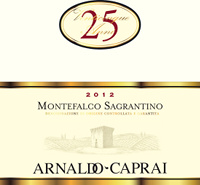
|
|
Montefalco Sagrantino 25 Anni 2012 |
|
| Arnaldo Caprai (Umbria, Italy) | |
 Sagrantino Sagrantino | |
| Price: € 60.00 | Score: |
 Deep ruby red and nuances of garnet red, little transparency. Deep ruby red and nuances of garnet red, little transparency. Intense, clean, pleasing, refined and elegant, starts with hints of
blackberry, black cherry and plum followed by aromas of violet, blueberry,
peony, vanilla, cocoa, cinnamon, tobacco, leather, pink pepper, carob and
menthol. Intense, clean, pleasing, refined and elegant, starts with hints of
blackberry, black cherry and plum followed by aromas of violet, blueberry,
peony, vanilla, cocoa, cinnamon, tobacco, leather, pink pepper, carob and
menthol.
 Tannic attack and however balanced by alcohol, full body, intense
flavors, agreeable. Tannic attack and however balanced by alcohol, full body, intense
flavors, agreeable.
 Very persistent finish with long flavors of blackberry, black cherry
and plum. Very persistent finish with long flavors of blackberry, black cherry
and plum.
 24 months in barrique, 8 months in bottle. 24 months in barrique, 8 months in bottle. |
|
 Game, Roasted meat, Stewed and braised meat, Hard cheese Game, Roasted meat, Stewed and braised meat, Hard cheese |
|
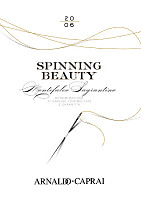
|
|
Montefalco Sagrantino Spinning Beauty 2006 |
|
| Arnaldo Caprai (Umbria, Italy) | |
 Sagrantino Cobra Sagrantino Cobra | |
| Price: € 200.00 | Score: |
 Deep ruby red and nuances of garnet red, little transparency. Deep ruby red and nuances of garnet red, little transparency. Intense, clean, pleasing, refined and elegant, starts with hints of
blackberry, prune and dried violet followed by aromas of blueberry,
tobacco, licorice, tamarind, vanilla, cocoa, leather, pink pepper, face
powder, mace, rosemary, cigar box and eucalyptus. Intense, clean, pleasing, refined and elegant, starts with hints of
blackberry, prune and dried violet followed by aromas of blueberry,
tobacco, licorice, tamarind, vanilla, cocoa, leather, pink pepper, face
powder, mace, rosemary, cigar box and eucalyptus.
 Tannic attack and however balanced by alcohol, full body, intense
flavors, pleasing roundness. Tannic attack and however balanced by alcohol, full body, intense
flavors, pleasing roundness.
 Very persistent finish with long flavors of blackberry, prune and black
cherry. Very persistent finish with long flavors of blackberry, prune and black
cherry.
 8 years in barrique. 8 years in barrique. |
|
 Game, Roasted meat, Stewed and braised meat, Hard cheese Game, Roasted meat, Stewed and braised meat, Hard cheese |
|
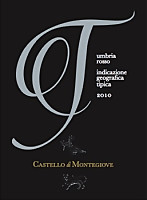
|
|
T 2010 |
|
| Castello di Montegiove (Umbria, Italy) | |
 Sagrantino Sagrantino | |
| Price: € 25.00 | Score: |
 Deep ruby red and nuances of garnet red, little transparency. Deep ruby red and nuances of garnet red, little transparency. Intense, clean, pleasing and refined, starts with hints of plum,
blackberry and dried violet followed by aromas of black cherry, blueberry,
tobacco, vanilla, leather, graphite, mace and menthol. Intense, clean, pleasing and refined, starts with hints of plum,
blackberry and dried violet followed by aromas of black cherry, blueberry,
tobacco, vanilla, leather, graphite, mace and menthol.
 Tannic attack and however balanced by alcohol, full body, intense
flavors, agreeable. Tannic attack and however balanced by alcohol, full body, intense
flavors, agreeable.
 Persistent finish with flavors of plum, blackberry and black cherry. Persistent finish with flavors of plum, blackberry and black cherry. 24 months in barrique and cask, 24 months in bottle. 24 months in barrique and cask, 24 months in bottle. |
|
 Game, Roasted meat, Braised and stewed meat, Hard cheese Game, Roasted meat, Braised and stewed meat, Hard cheese |
|
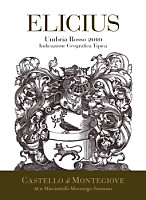
|
|
Elicius 2010 |
|
| Castello di Montegiove (Umbria, Italy) | |
 Montepulciano (70%), Sagrantino (30%) Montepulciano (70%), Sagrantino (30%) | |
| Price: € 22.00 | Score: |
 Intense ruby red and nuances of garnet red, little transparency. Intense ruby red and nuances of garnet red, little transparency. Intense, clean, pleasing, refined and elegant, starts with hints of
plum, black cherry and blackberry followed by aromas of dried violet,
blueberry, tobacco, blackberry, chocolate, leather, vanilla, cinnamon, mace
and menthol. Intense, clean, pleasing, refined and elegant, starts with hints of
plum, black cherry and blackberry followed by aromas of dried violet,
blueberry, tobacco, blackberry, chocolate, leather, vanilla, cinnamon, mace
and menthol.
 Properly tannic attack and however balanced by alcohol, full body,
intense flavors, pleasing roundness. Properly tannic attack and however balanced by alcohol, full body,
intense flavors, pleasing roundness.
 Persistent finish with flavors of plum, black cherry and blackberry. Persistent finish with flavors of plum, black cherry and blackberry. 18 months in barrique and cask, 12 months in bottle. 18 months in barrique and cask, 12 months in bottle. |
|
 Game, Roasted meat, Stewed and braised meat, Hard cheese Game, Roasted meat, Stewed and braised meat, Hard cheese |
|
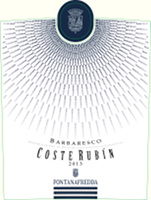
|
|
Barbaresco Coste Rubin 2013 |
|
| Fontanafredda (Piedmont, Italy) | |
 Nebbiolo Nebbiolo | |
| Price: € 25.80 | Score: |
 Brilliant ruby red and nuances of garnet red, moderate transparency. Brilliant ruby red and nuances of garnet red, moderate transparency. Intense, clean, pleasing and refined, starts with hints of cherry, plum
and violet followed by aromas of raspberry, strawberry, blueberry, rose,
vanilla, tobacco, cinnamon and menthol. Intense, clean, pleasing and refined, starts with hints of cherry, plum
and violet followed by aromas of raspberry, strawberry, blueberry, rose,
vanilla, tobacco, cinnamon and menthol.
 Tannic attack and however balanced by alcohol, full body, intense
flavors, pleasing crispness. Tannic attack and however balanced by alcohol, full body, intense
flavors, pleasing crispness.
 Persistent finish with flavors of cherry, plum and raspberry. Persistent finish with flavors of cherry, plum and raspberry. 12 months in cask and barrique. 12 months in cask and barrique. |
|
 Game, Roasted meat, Stewed and braised meat with mushrooms, Hard cheese Game, Roasted meat, Stewed and braised meat with mushrooms, Hard cheese |
|
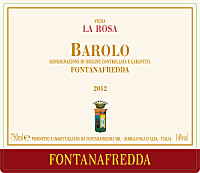
|
|
Barolo Vigna La Rosa 2012 |
|
| Fontanafredda (Piedmont, Italy) | |
 Nebbiolo Nebbiolo | |
| Price: € 55.00 | Score: |
 Brilliant ruby red and nuances of garnet red, moderate transparency. Brilliant ruby red and nuances of garnet red, moderate transparency. Intense, clean, pleasing and refined, starts with hints of cherry, plum
and raspberry followed by aromas of violet, rose, blueberry, tobacco,
vanilla, cinnamon and menthol. Intense, clean, pleasing and refined, starts with hints of cherry, plum
and raspberry followed by aromas of violet, rose, blueberry, tobacco,
vanilla, cinnamon and menthol.
 Tannic attack and however balanced by alcohol, full body, intense
flavors, pleasing crispness. Tannic attack and however balanced by alcohol, full body, intense
flavors, pleasing crispness.
 Persistent finish with flavors of cherry, plum and raspberry. Persistent finish with flavors of cherry, plum and raspberry. 24 months in cask, 18 months in bottle. 24 months in cask, 18 months in bottle. |
|
 Game, Roasted meat, Braised and stewed meat, Hard cheese Game, Roasted meat, Braised and stewed meat, Hard cheese |
|

|
|
Montecucco Sangiovese Riserva Viandante 2011 |
|
| Tenuta L'Impostino (Tuscany, Italy) | |
 Sangiovese Sangiovese | |
| Price: € 19.00 | Score: |
 Intense ruby red and nuances of garnet red, little transparency. Intense ruby red and nuances of garnet red, little transparency. Intense, clean, pleasing and refined, starts with hints of black
cherry, plum and dried violet followed by aromas of blueberry, blackberry,
vanilla, tobacco, raspberry, chocolate, mace and menthol. Intense, clean, pleasing and refined, starts with hints of black
cherry, plum and dried violet followed by aromas of blueberry, blackberry,
vanilla, tobacco, raspberry, chocolate, mace and menthol.
 Properly tannic attack and however balanced by alcohol, good body,
intense flavors, pleasing crispness. Properly tannic attack and however balanced by alcohol, good body,
intense flavors, pleasing crispness.
 Persistent finish with flavors of black cherry, plum and blueberry. Persistent finish with flavors of black cherry, plum and blueberry. 24 months in barrique, 6 months in bottle. 24 months in barrique, 6 months in bottle. |
|
 Roasted meat, Stewed meat with mushrooms, Hard cheese Roasted meat, Stewed meat with mushrooms, Hard cheese |
|

|
|
Lupo Bianco 2011 |
|
| Tenuta L'Impostino (Tuscany, Italy) | |
 Sangiovese (60%), Merlot (40%) Sangiovese (60%), Merlot (40%) | |
| Price: € 32.00 | Score: |
 Brilliant ruby red and nuances of garnet red, little transparency. Brilliant ruby red and nuances of garnet red, little transparency. Intense, clean, pleasing, refined and elegant, starts with hints of
plum, black currant and black cherry followed by aromas of dried violet,
blueberry, vanilla, tobacco, blackberry, cocoa, licorice, cinnamon,
leather and eucalyptus. Intense, clean, pleasing, refined and elegant, starts with hints of
plum, black currant and black cherry followed by aromas of dried violet,
blueberry, vanilla, tobacco, blackberry, cocoa, licorice, cinnamon,
leather and eucalyptus.
 Properly tannic attack and however balanced by alcohol, full body,
intense flavors, pleasing roundness. Properly tannic attack and however balanced by alcohol, full body,
intense flavors, pleasing roundness.
 Persistent finish with flavors of black currant, black cherry and plum. Persistent finish with flavors of black currant, black cherry and plum. 24 months in barrique, 6 months in bottle. 24 months in barrique, 6 months in bottle. |
|
 Game, Roasted meat, Stewed and braised meat, Hard cheese Game, Roasted meat, Stewed and braised meat, Hard cheese |
|
|
||||||||
|
DiWineTaste Polls
|
| |||||||
Privacy Policy | |||||||


| Copyright © 2002-2024 Antonello Biancalana, DiWineTaste - All rights reserved |
| All rights reserved under international copyright conventions. No part of this publication and of this WEB site may be
reproduced or utilized in any form or by any means, electronic or mechanical, without permission in writing from DiWineTaste. |